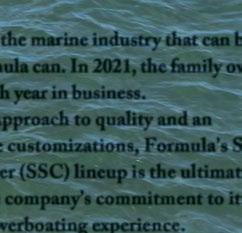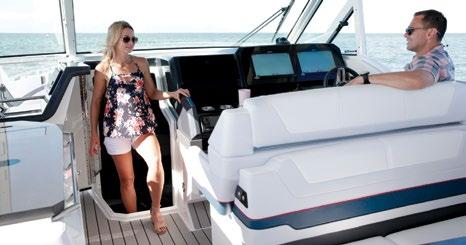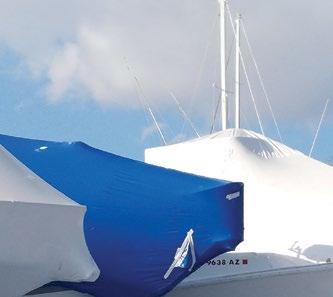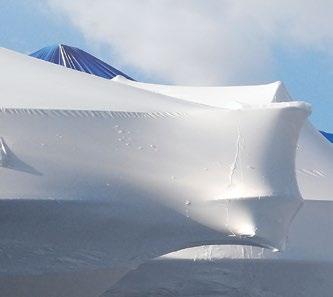
15 minute read
Boat Test: Formula 380 SSC Outboard
Formula 380 SSC Outboard








No compromise. by Chuck Warren
There aren’t many brands in the marine industry that can boast
a six-decade history. Formula can. In 2021, the family owned company will celebrate its 65th year in business.
With its uncompromising approach to quality and an incredible variety of available customizations, Formula’s Super Sport Crossover (SSC) lineup is the ultimate example of the company’s commitment to its customers’ powerboating experience. Now available in an outboard configuration, the Formula 380 SSC perfectly fits the wants and needs of today’s breed of boater. In the 21st century, we want everything and we want it now. We want to have our cake and eat it too, and the new 380 SSC Outboard delivers.








Tailor made Instead of using an existing design and bolting on a bunch of engines, the 380 SSC Outboard hull was specifically created for the new configuration. Based on Formula’s FAS 3 Tech stepped hull design, the outboard model was built to ensure the boat’s performance and handling would meet Formula’s exacting standards.
Stepping aboard, the 380 SSC Outboard’s large swim platform provides easy access to the cockpit, even with the three big engines hanging off the tail end. There is also plenty of room to climb in and out of the water, and dual swim ladders make it easy.
Forward, the huge cockpit occupies the full width of the boat, as does the standard hardtop with its retractable roof. The cockpit is one single level, so from the moment you step through the transom to the farthest seat forward, there are no steps up or down.
Nautolex vinyl seating wraps completely around the cockpit, with hinged cushions hiding plenty of finished storage below. The starboard aft seat can also convert into a comfortable aft-facing sunpad.
The starboard-side U-shaped lounge seating can also convert into a large sunpad with the help of two cockpit tables. When not in use, the tables easily slide beneath the seats.
A switch raises the port aft seat to expose the mechanical room below. Without the sterndrive engines the space can be used for storage, and checking the oil on the 7.5kW generator is a painless operation.
Back on deck and to port, an outdoor galley includes a cold storage drawer and sink hidden beneath a large counter made for serving plenty of food and drinks. Just ahead, cabinet doors hide space for kitchen accessories, a real trash can and the cockpit-mounted TV. A transommounted grill is also available to accent the outdoor galley.
At the helm, seating for three converts into bolsters behind the adjustable wheel. Two 12-inch Raymarine Axiom touch panels control navigation and onboard systems, while Mercury’s VesselView provides engine and cruising data, and a Mercury Joystick gives the captain complete control.
Forward, the walkthrough windshield smoothly slides aside to provide access to the bow. Seating with storage below hinged cushions wraps around the bow, while plenty of cupholders and USB ports keep guests comfortable and connected.
Down below Standing at the helm, the cabin door could be easily missed. Swing open the big portside door and step below to find (even with the single-level cockpit) that Formula did not compromise on cabin space in the 380 SSC Outboard either.
Headroom in the 380 SSC Outboard cabin is impressive at 6 feet, 5 inches. The roomy, well-lit space includes a cold storage drawer, sink, microwave and pantry. Another dinette table also converts the forward

seating into a bunk with the help of a flip-up backrest that creates additional legroom.
To starboard, a roomy wet head is well-appointed with plenty of storage and a huge mirror. Just aft, the full-width stateroom was designed with enough headroom to climb in and easily sit up. There is space for two to sleep comfortably, and a 32-inch TV to port provides entertainment.
In a boat dominated by cockpit space, the cabin could feel like an afterthought. However, the 380 SSC Outboard cabin is easily accessible and big enough to spend a weekend away with no compromise on comfort or convenience.
Powerful performance Available with a variety of power options in addition to the standard triple Mercury 350s, our test boat came with three Mercury Racing 450R engines. No longer the noisy, smelly beasts that outboards once were, today’s four-cycle engines are smooth and quiet.
At 38 feet long and 11 feet, 6 inches wide, the 380 SSC Outboard is a big boat. However, as we throttled up, the stepped hull lifted the vessel up on plane with minimal bow rise. The boat handled the lake’s not-quite-moderate chop with ease, while topping out at 67 mph.
Even with the big Mercury 450s running at 4500 rpm, which pushed the boat to 42 mph, there was no trouble talking over the engine noise without raising our voices.
The ride and handling was exactly what I expected from Formula. The boat is fast and digs into turns like it’s on rails. There are no rattles or clunks whether running at top-end or fast-idling back to the dock.
Formula could easily create a standard graphics and design package and charge its buyers extra to customize their new boat. However, through the company’s FormulaFlex and MyWay programs, customers are offered nearly endless combinations of hull and trim colors, graphic designs, and interior base and accent color options. That means Formula owners can match their boat to their favorite colors, their car, or even Alma Mater.
The new Formula 380 SSC Outboard is a fun, fast, capable sport cruiser with the performance to pull wakeboarders and tubes, and still features plenty of room for entertaining and overnight trips.
Performance, style, quality and comfort — for 65 years, Formula has mixed them together without compromising on a single ingredient. H


FORMULA 380 SSC OUTBOARD
SPECIFICATIONS LOA: 38’ Beam: 11’6” Draft: 3’5” Fuel Capacity: 300 gals. Water Capacity: 43 gals. Power (as tested): 3 x Mercury 450R MSRP (w/ 3 x 450Rs):$1,032,870 MSSP: $748,270
FORMULABOATS.COM
DEALERS
Chicago Yachts Works CHICAGOYACHTWORKS .COM Lakeside Formula LAKESIDEFORMULA .COM Marine Tech Concepts MARINETECHCONCEPTS.COM

Cold storage in cabin and cockpit Single level cockpit Sliding walkway window Slide-away cover for galley sink Dash includes a huge glovebox Single-color LEDs in all accent lighting
Adventures in




Preparing your boat for the winter requires a bit of elbow grease but is well worth the effort. by Felicia Schneiderhan





Winterizing

You may remember a dramatic climax of the 1987 movie “Adventures in Babysitting” when kids hang off the diagonal roof of Chicago’s 150 North Michigan Avenue skyscraper. Twenty years later, when my husband, Mark, and I lived on our Marine Trader trawler, Mazurka, just a few blocks from there, I would look up at that iconic building on icy winter nights and think, yep, boat life during the Midwest winter is just like that — hanging off a diagonal roof, slowly sliding down.
As live-aboards, we never had to winterize the engine or plumbing systems, since we kept the boat heated and needed the plumbing to work. We did shrinkwrap the top to avoid the ill-effects of ice, wind and snow damage. Still, one year we waited too long and the snow piled up. Shrinkwrapping the top kept the cabin a lot warmer, too. We also suspended a de-icer (a big fan) in the Chicago River to circulate the water around the boat and keep things from freezing. Though one year we waited too long for this, too, and came home one subzero February weekend to find the entire Chicago River frozen, encasing the live-aboards in ice. We started up the engine to keep things going, lest we turn into Shackleton’s Endurance. By some not-so-small miracle, we avoided any hull damage.
These days, with three kids, our live-aboard winter days are over. We moor Mazurka on Lake Superior and haul her out for a complete winterizing in the fall. Mark does almost everything himself, except for shrinkwrapping, which the marina rules dictate must be done by its employees (no doubt some insurance rule, and also probably not trusting a bunch of boaters wielding blowtorches).
Of course, there’s a simple way to winterize: Pay somebody else to do it. But for those of us who appreciate the DIY aspect of boating, winterizing the boat can be satisfying and even enjoyable. All you need is your boat’s manual and, say, four free weekends. And those four weekends are going to give you what you really need to know about winterizing your boat: Experience. You’ll glean plenty more stories to share with fellow DIY boaters. And it’s a good chance to call on friends for an end-of-season party to Shop-Vac every last drop of nasty water in the bilge.
Water is the biggest threat, summer or winter. During winter, your boat

can suffer damage from freezing, corrosion, and mold and mildew. Built-up ice can pop hatches and bust window tracks. Water in your engine or gear case can crack a housing or block and cost thousands to repair. So getting rid of every last drop possible will save a lot of heartache down the line. As Mark likes to say, “There are mistakes and there are ching-ching mistakes.”
Engine first: Outboards, inboards & sterndrives The first and most obvious step to winterizing your engine is to read your boat’s owner’s manual. But just in case that manual is lost, moldy, missing pages, or
My son, 9-year-old Rafael, caulks the seal around the lazarette
(Top) Shop-Vac, tools, wires everywhere: Winterizing can look (and feel) like complete chaos. (Bottom) Keeping the crew busy for a day of winterizing sometimes means essential tasks like vacuuming the bow (and snacks — lots of snacks).

you just like reading as much as you can about your baby, here’s a quick overview of engine care. You may also want to check quality online resources, like BoatUS manuals.
Besides high-ticket freezing damage, your engine could suffer corrosion or fuel degradation during the cold months. Even a tiny bit of water hanging out in the engine can cause a lot of damage if it freezes.
For an outboard engine, you’ll have to first flush the engine with freshwater, using a flushing attachment

or running the motor in clean water. Empty the carburetors and fuel lines by disconnecting the fuel line while the engine’s still running. Before it runs out of fuel, spray the aerosol fogging oil into the carburetors. Next, take the motor out of the flush tank or disconnect the flush attachment. Let the water drain out and open the drain plugs; crank the motor by hand to empty the water pump. Take out the spark plugs and coat the cylinders with fogging oil, then spread the oil on the walls by rotating the flywheel. Double-check the quality of the spark plugs, and reinstall or replace them. Clean the gears and pivots and lubricate them with oil or grease, drain and refill the gearcase and oil tank. Make sure to drain all the fuel in the tank and fuel supply lines. If you’re not able to completely empty the tank, fill it to 95% full and stabilize it. Clean and lubricate the propeller shaft and store it upright.
Inboards and sterndrives will need to be filled with propylene glycol antifreeze to prevent tiny ice pockets that can crack the block. For an inboard motor, change the coolant, as well as the engine and transmission oil. For diesel engines, fill up the fuel tanks and add biocide. For gasoline engines, run the engine out of fuel and fog the intake, then drain the fuel tank and supply lines. Flush the raw-water circuit, and protect the raw-water passages on your diesel engine by draining them, reconnecting the water-pump outlet hose, and using a funnel to add in the antifreeze. Let it sit for a few minutes, then open the raw-water drain plugs and drain it. Remove the impeller. Fog the cylinders on the gasoline engine, or fog the intake for the diesel engine. Drain the muffler canister. With a sterndrive, BoatUS recommends following the inboard to-do list, with a few tasks from the outboard for the lower end, and also filling the drive shaft housing with lubricant.
Make sure to change the oil and oil filter, gear lube, and replace the fuel filter. Remove the battery. Come spring, you’ll be glad you changed the water pump impeller, too.
Plumbing Now drain all the water from the plumbing and water systems, including freshwater tanks, heads/ sewage, power wash, bilge pumps, air conditioners and random cans of fizzy water. An onboard Shop-Vac could be the next tool you can’t live without; it makes siphoning water out of those hard to reach places so much easier.
Drain all the plumbing and add antifreeze. If anything is removable (like heads or filters), take it out. This seems obvious, but twice we left the drinking water filters onboard all winter, and twice they were wrecked. Remove the drain plugs. Then get down to every last drop by meticulously combing through all the other systems that hold water: Raw-water washdowns, livewells and
bilge pumps. A good, strong wet/dry Shop-Vac is excellent for this job. It’s also a good task to delegate to a kid or those of us not engine-savvy.
Wrap it up If you have or can rent a garage big enough for your boat, you’re golden. If not, you’ll need an outdoor location, which means tucking in your boat with a tarp or shrinkwrap.
Among the winter liveaboards in Chicago, annual shrinkwrapping was an art to behold. Out came the PVC pipe and two-by-fours, the blowtorches, and mounds of strong shrinkwrap plastic and tape. Building the structure to hold the shrinkwrap was one of Mark’s favorite activities, something he tried each year to improve. We needed something strong to hold up to the Windy City.
These days, it’s not nearly as exciting. The guys at the marina do it, and we don’t even get to light the torch.
Once your boat is out of the water, it needs a good, strong pressure-washing. Check the hull for stress cracks, gelcoat blisters, and that one spot you remember hitting a rock on last July. Some experts recommend puncturing the blisters to drain and dry them, then patching with an epoxy-based filler.
A frame is essential, whether you’re using a polytarp cover or shrinkwrap; the frame ensures the weight of snow and ice are distributed equally (think diagonal roof). You can also buy a special kit with reusable aluminum tubing and clamps, or you can build your own with two-by-fours and PVC piping, strong strapping and your crew’s help. Make sure to minimize the amount of plastic that lays against the fiberglass, because moisture will build up, especially if you heat it.
Keep in mind, shrinkwrap needs to be vented for good airflow, lest you open the boat in the spring to find everything coated in mold. This happened to us one year when we left the boat covered in shrinkwrap for an entire season, which is definitely not advisable — especially if it’s not vented properly.
One last thing… There’s always one last thing on a boat (or more like 100 little one last things).
The whole interior of your boat is likely damp, and everything — from the cupboards to the vinyl seat covers — needs to be cleaned and dried, A mildew spray can help, plus a few buckets of moisture absorber open and ready. Because dry winters suck the life out of vinyl, you may want to spray the vinyl interior with a cleaner and protectant to prevent cracking. Put everything away dry or else it will mildew; this includes life jackets, deck furniture, the Zodiac raft and that bunch of towels somebody forgot in the shower. It can be good practice to take home sensitive, removable items like compasses, the radar/chartplotter, the radio and speakers.
Then say goodbye — but

not for too long; it’s advisable to visit your vessel every few weeks just to be safe. She might be lonely out there. No doubt you are missing her, too. ★











